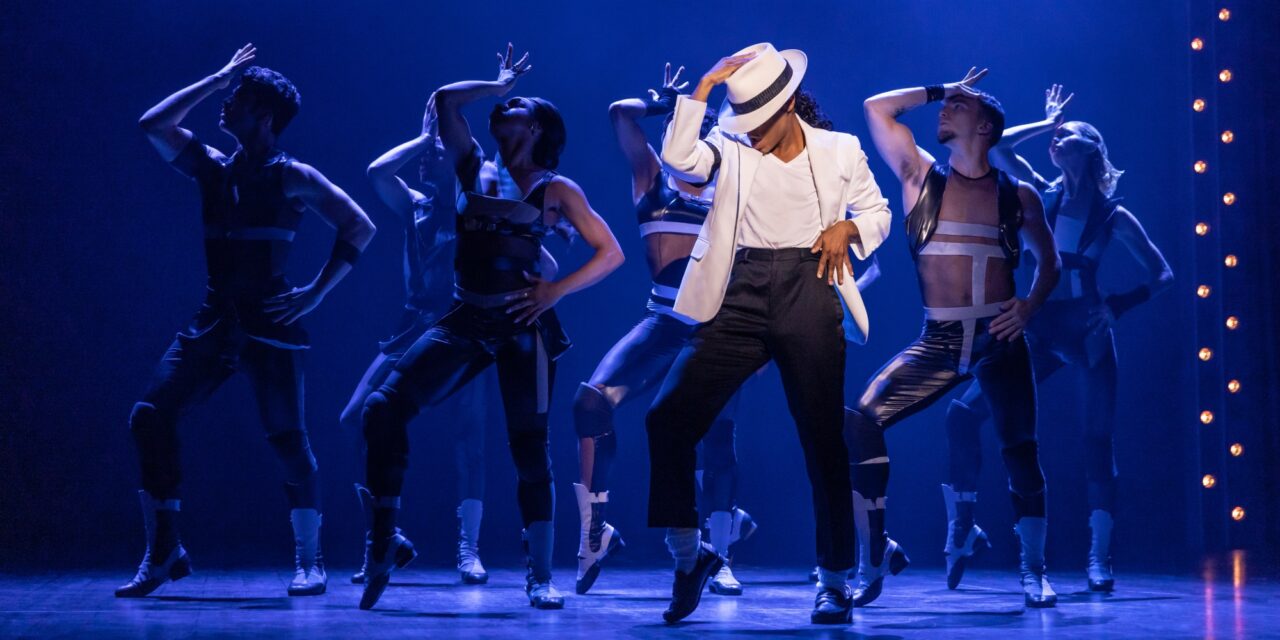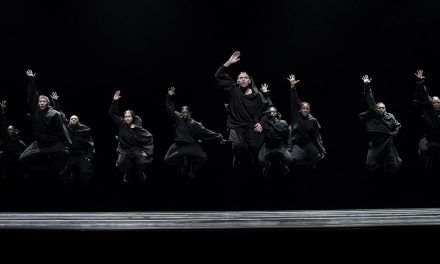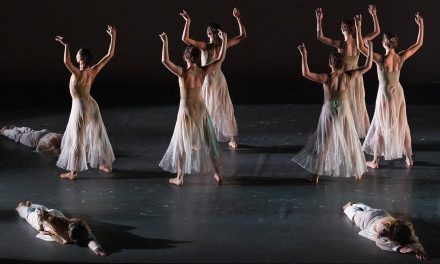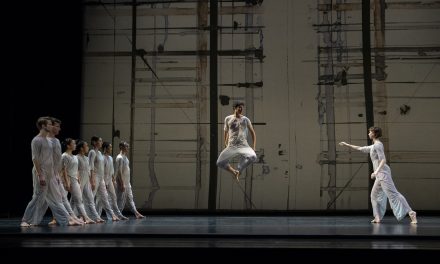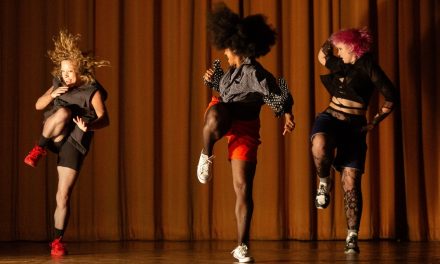The dancers and other staff mill around the stage. The Segerstrom Center for the Arts audience is settling in and most of the people did not seem to realize the show had started. A rehearsal studio, complete with dancers in rehearsal clothes warming up, singers vocalizing, technical crew moving around, and a stage manager barking orders. There is a brief improvisation section that is led by Michael and features a New Jack beat provided by the band. The musicality of his movement to the New Jack beat is hypnotizing. He listens intently and creates choreography that is amazing to watch. It feels visceral and organic. MJ, though speaking softly, is obviously in charge and with a wave and change of lighting the fun begins with a choreographed warm up and a smooth transition into Beat It! Choreography was sharp and clean and reminiscent of the original work of Michael Peters. This Michael Jackson embodies the energy and style of the one and only King of Pop and we have been transported from rehearsal to a performance! This is going to be quite an exciting and entertaining evening.
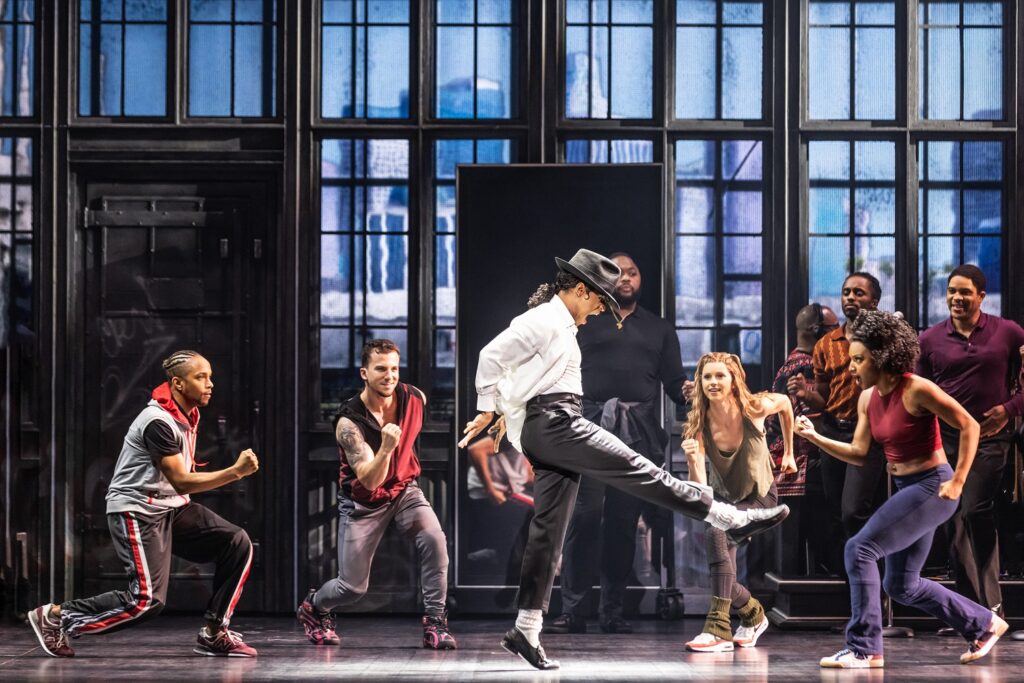
01. Roman Banks as ‘MJ’ and the cast of the MJ First National Tour – Photo by Matthew Murphy, MurphyMade.
The fun turns to poignancy as Michael begins to express his reluctance to be interviewed and have cameras in his rehearsal room. There is a sadness and foreboding because I am sure most of the audience knows that Michael will endure a lengthy trial and pass away at a very young age. “Tabloid Junkie,” “Price of Fame,” “Climb Every Mountain” were perfect song selections and certainly demonstrated the power of music. As the show rapidly moves through his life we learn that he is preparing for the Dangerous tour and is focused on raising funds for his Heal The World Foundation. The discussion about Vitiligo and Michael’s recounting of the terrible accident during the Pepsi commercial and almost every scene with Joseph is tinged with poignancy.
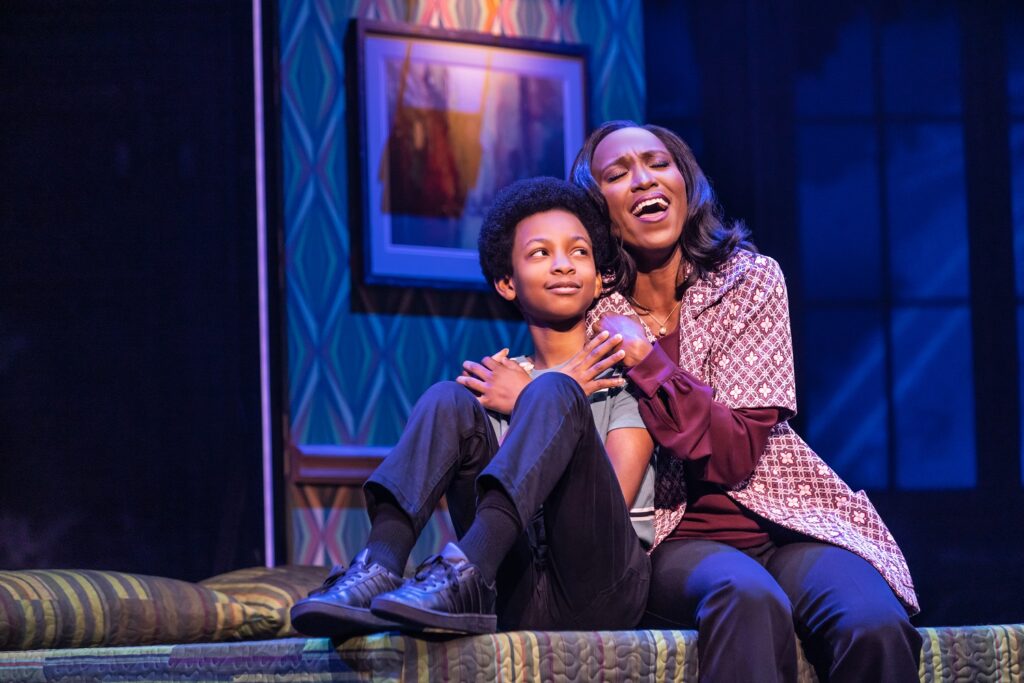
Josiah Benson as ‘Little Michael’ and Anastasia Talley as ‘Katherine Jackson’ in the MJ First National Tour – Photo by Matthew Murphy, MurphyMade.
The characters of his father and mother, Joseph and Katherine build slowly. Despite the focus on music and dancing these pivotal characters come to life during the play. They are multidimensional people, and you see the positives and negatives in their child rearing practices however their dialogue can be preachy and predictable from time to time. The stage manager, Rob the reporter and cameraman develop relationships with MJ and engage in dialogue that is essential in setting the tone for the story that is being told. Rob, who doubles as Michael’s father Joe and, ironically, as the tour manager is a surrogate father to Michael. The brothers are talented singers, dancers, and actors but their dialogue is very limited. It is very clear that the playwright, Lynn Nottage has a very specific purpose for each character and most of the other characters (Quincy Jones, Berry Gordy, Don Cornelious, Suzanne de Passe, and the Jackson brothers) are somewhat bland and one dimensional. Even with that said, they serve their purpose well of moving the story along and their relationships with Michael certainly give insight into his character.
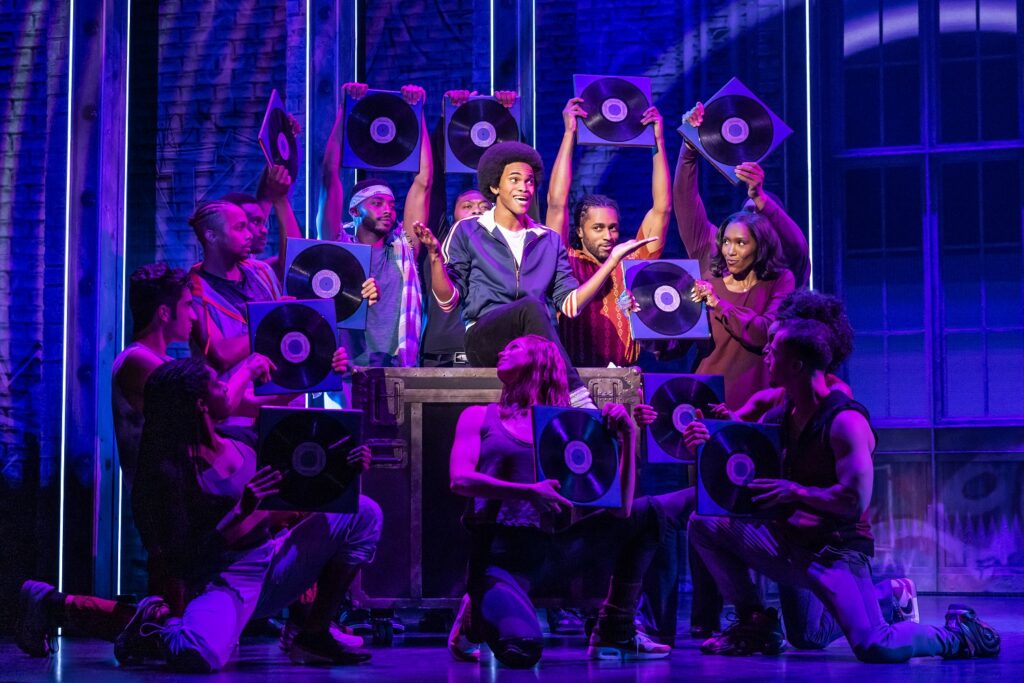
Brandon Lee Harris as ‘Michael’ and the cast of the MJ First National Tour – Photo by Matthew Murphy, MurphyMade.
The Michael Jackson catalogue is overflowing with music that makes you move and music that makes you think. Throughout the show you can hear audience members happily singing along. The music is the driving force behind the success of this production and people immediately connect to it. Having grown up attending the annual Motown Review in Detroit the sound is easily identifiable. It is genre of music and hybrid that has elements of Pop, Soul, Gospel, and R&B. It is characterized by a driving bass line, lush strings, and horns and this orchestra is masterful in its interpretation of the music. The addition of the electronic musical elements and the pure energy and exceptional sound design of the show serve the production well transitioning the audience from intimate settings to rehearsal and to the concert stage.
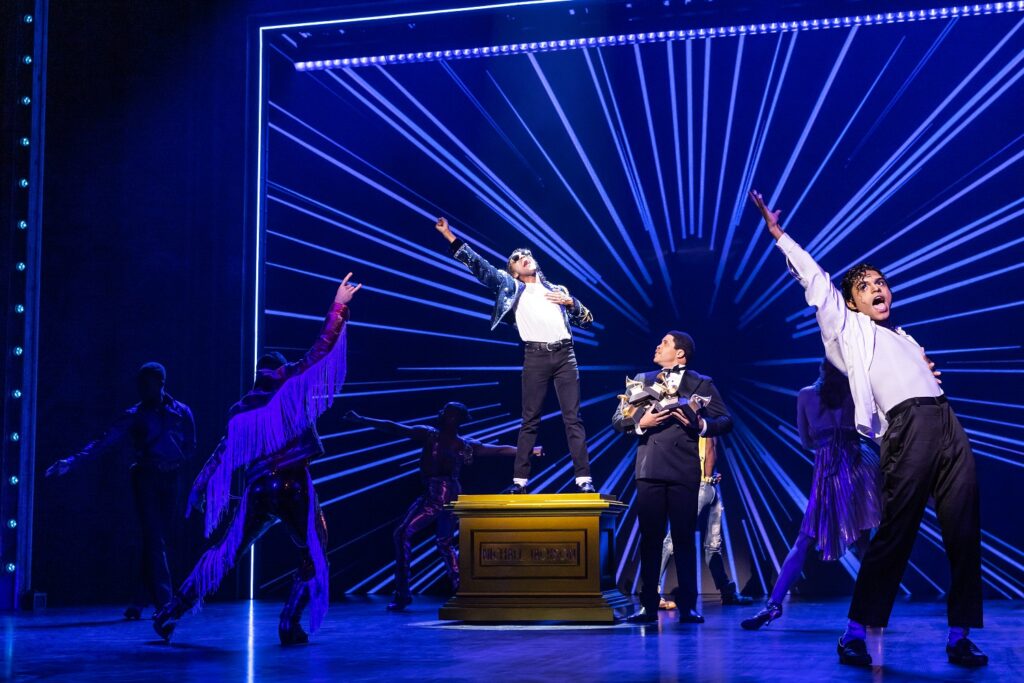
Brandon Lee Harris as ‘Michael’ Josh A. Dawson as ‘Quincy Jones’ Roman Banks as ‘MJ’ and the cast of the MJ First National Tour – Photo by Matthew Murphy, MurphyMade.
While the music is the driving force the dance is the ultimate compliment to the music. It is a partnership that flourishes from the opening to the end of the show. Choreographer, Christopher Wheeldon creates choreography that often pays homage to the work of Michael Peters, Greg Burge, Vincent Paterson & Michael Jackson himself. Iconic movement phrases are immediately recognizable but the influences of balletic lines, hip hop and contemporary modern dance add another dimension to the movement. All of the dancers are well-trained and versatile, and the chorus is most exciting when they are working in unison. The contemporary modern choreography for “Human Nature” was especially interesting. The movement was filled with emotion and long balletic lines as they moved large letters around the stage facilitating a scene change.
Choreographically speaking, the sequence of choreographic influences was my least favorite. The Nicholas Brothers, Fred Astaire, and Bob Fosse styles are represented, however the movement is neither interesting nor inspiring. The Fosse section was the most motivating and that was largely due to the length of the segment, the number of dancers moving in unison, and the unique use of musical rhythmic phrases to accent movements.
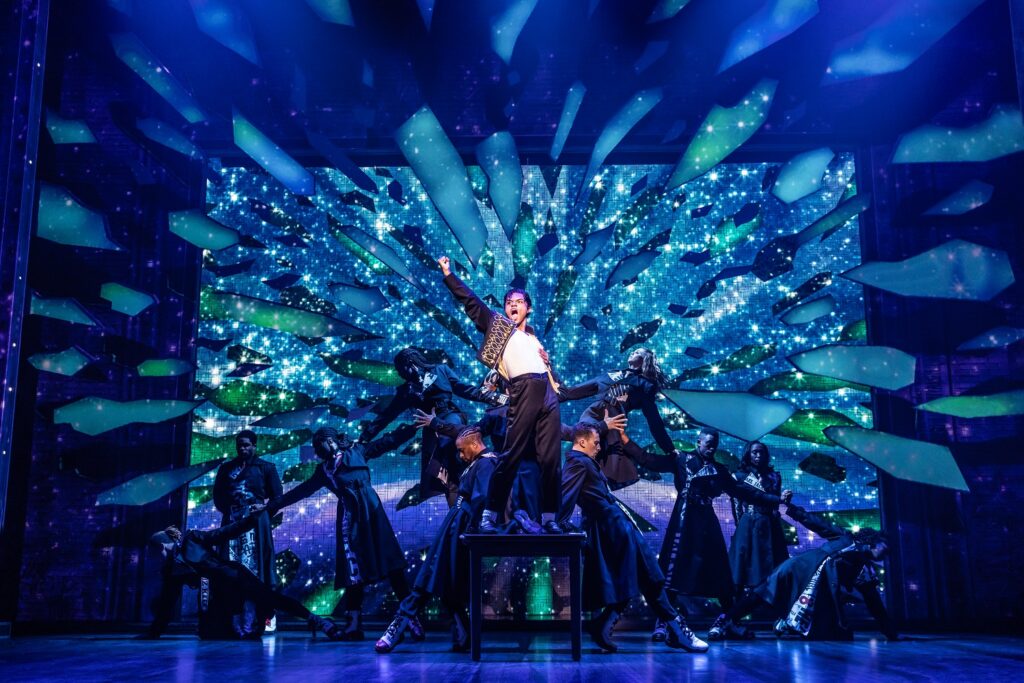
Roman Banks as ‘MJ’ and the cast of the MJ First National Tour – Photo by Matthew Murphy, MurphyMade.
Rich and Tone Taluega, credited with the Michael Jackson movement, are to be commended for their ability to recreate and/or reimagine the signature nuances of all the Michaels. They have done a masterful job creating choreography that demonstrates the changes that occur as Michael grows from a young child to a troubled adult.
Now, to the Michael Jacksons! Each one is an unbelievable triple threat that sings, acts, and dances. The sheer confidence, commitment, and energy that each exhibit whenever they are on the stage is mind blowing. MJ (Roman Banks) creates a star persona, and you believe that he IS the iconic King of Pop. Little Michael (Bane Griffith) who performs the lead in ABC is a twirling, stop on a dime, child prodigy, talented far beyond his years. Teenage Michael (Brandon Lee Harris) is the conflicted teen, beginning to come into his own and maturing as a dancer and singer as he begins to perfect his signature moves. The high-spirited bows that close the show give all the Michaels and their understudies the opportunity to shine. These artists are all truly remarkable and comprise the glue that holds the show together.
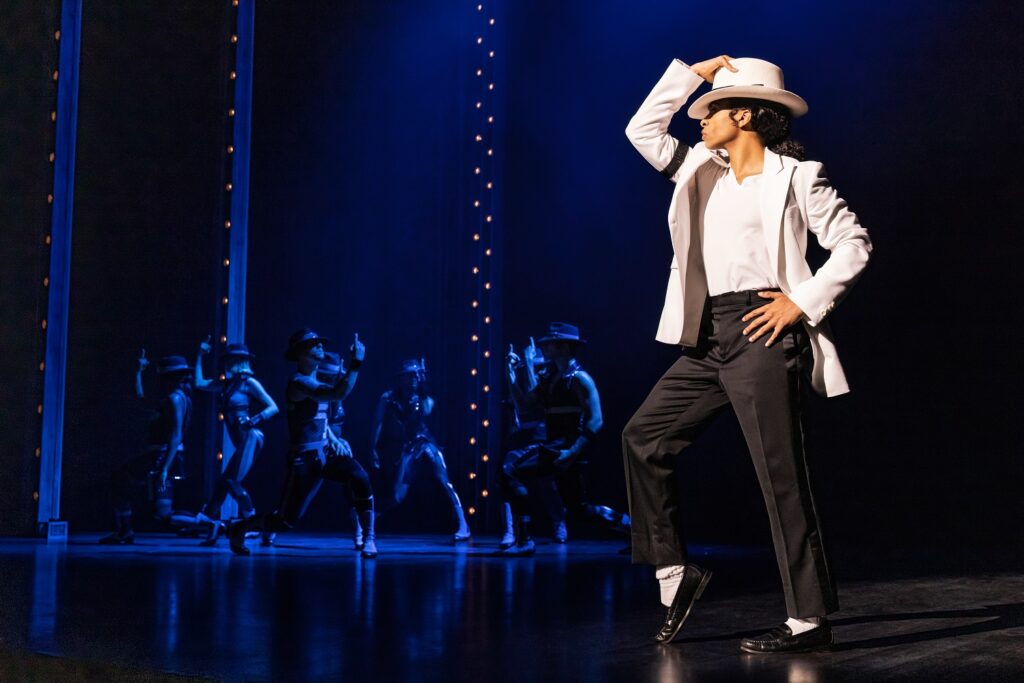
Jamaal Fields-Green as ‘MJ’ and the cast of the MJ First National Tour – Photo by Matthew Murphy, MurphyMade.
Music and dance form the basis of the powerful, exciting, and explosive transitions that keep the show moving at a breakneck pace. Most transitions explode with lights, sound, and high energy dancing. The transitions to “Blame It on The Boogie,” “Thriller,” the press conference and group of shouting reporters, “Billie Jean,” and “Smooth Criminal” were extremely effective and even elicited applause and shouts from the audience. Transitions graduate in power and MJ becomes larger than life as he remembers performing at the Apollo Theatre, moves into “Man in The Mirror” and then arrives center stage poised to begin his tour.
For more information about The Segerstrom Center for the Arts, please visit their website.
Written by Leah Bass-Baylis for LA Dance Chronicle.
Featured image: Roman Banks as ‘MJ’ and the cast of the MJ First National Tour – Photo by Matthew Murphy, MurphyMade.

